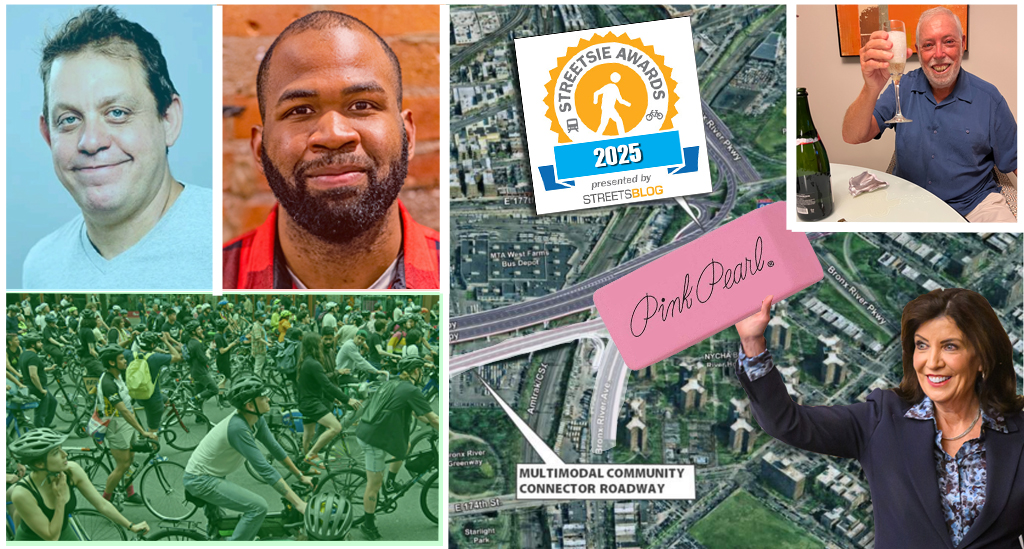A group of 12 prominent former transportation officials told the Federal Aviation Administration yesterday that it should move forward with approval for the controversial LaGuardia AirTrain.
The signatories, who worked for the city and state departments of transportation and for the Metropolitan Transportation Authority, stated their “clear view and strong opinion” that the proposed Willets Point route — the only one being advanced by the Port Authority of New York and New Jersey — meets conditions for viability, including “minimal environmental impacts; little or no private land taking; solid planning and forecasting; reasonable and predictable costs; and strong champions to see the project through.”
Moreover, they dismissed proposed transit and bus alternatives to the AirTrain — some 47 were considered at earlier stages of the project — as unworkable.
The proposed $2-billion elevated people-mover — a favorite project of Gov. Cuomo — would run mostly alongside the Grand Central Parkway and the Flushing Bay promenade on a 1.5-mile route between LaGuardia Airport in East Elmhurst and Willets Point, where it would connect to the 7 subway line and the Long Island Rail Road’s Port Washington branch, a spur that does not connect to the Jamaica hub.
The letter comes as the FAA is holding its first virtual hearing on the draft environmental impact statement for the troubled project. The Port Authority, the project’s sponsor, has asked the federal government for funding for the AirTrain after the agency’s revenues fell precipitously because of the COVID-19 pandemic. It is not clear whether the feds will offer up the money; Cuomo recently complained that President Trump was delaying the project — though not likely because he is listening to project opponents, who have for years argued that it adds little to the transit system, especially given its price tag.
The signatories, however, wrote that proposed AirTrain alternatives, such as extending the N train to LaGuardia “would require construction of an enormously expensive and technically difficult tunnel” and “the taking of dozens of private properties, causing massive disruption to communities” and “expensive, time consuming ... litigation.”
Bus lanes, another alternative favored by AirTrain detractors, would be almost as complicated, the machers suggested.
“Even with dedicated lanes, buses would be required to fight Manhattan traffic as they cross signal controlled, heavily congested or blocked intersections,” the signatories wrote. That's because:
- "Taking away one lane in each direction from any of the East River crossings, which are already jammed to capacity, would create severe bottlenecks." [This point is questionable, given the rule of induced demand.]
- "It would also be very difficult to justify re-purposing two busy lanes to support just a handful of buses per hour. In fact, it would be impossible to do at the Queens-Midtown Tunnel, which has only one lane Queens-bound today during the morning peak, unless the inbound bus and HOV lane were discontinued. Hundreds of buses and tens of thousands of passengers would then face severe delays."
- "Similarly, taking lanes from the Grand Central Parkway, the Long Island Expressway and/or Brooklyn-Queens Expressway links to the airport would create enormous delays, dramatically increase pollution and greenhouse gases, and spark fierce outrage.”
The AirTrain, meanwhile, “would take no private land” and it “would generate at least $35 million in capital investments for the long-neglected Flushing Bay Marina and Promenade” next to its route.
The signatories were:
- Michael Fleischer, former NYSDOT deputy commissioner and former NYSTA executive director
- Michael Horodniceanu, former MTA capital construction president and former NYCDOT traffic commissioner
- Maria Lehman, former NYSTA acting executive director and director of operations
- Thomas Madison, Jr., former NYSDOT commissioner, former NYSTA executive director and former FHWA Administrator
- Stephen Morgan, former NYSTA executive director
- Thomas Prendergast, former MTA chairman and CEO, and former president MTA NYCT
- Lucius Riccio, former NYCDOT commissioner
- Elliot Sander, former MTA CEO and former NYCDOT commissioner
- Ross Sandler, former NYCDOT commissioner
- Michael Shamma, former NYSTA chief engineer and former NYSDOT chief engineer
- Sam Schwartz, former NYCDOT traffic commissioner and chief engineer best known as "Gridlock" Sam
- Gerard Soffian, former NYCDOT deputy commissioner.
Not everyone was so impressed by the "big names."
This letter is embarrassing for everyone who signed it, and the day we take more capital planning advice from Horodniceanu should be a cold day in hell. https://t.co/McdISJYUTa
— Second Ave. Sagas (@2AvSagas) September 22, 2020
Here's the letter:






